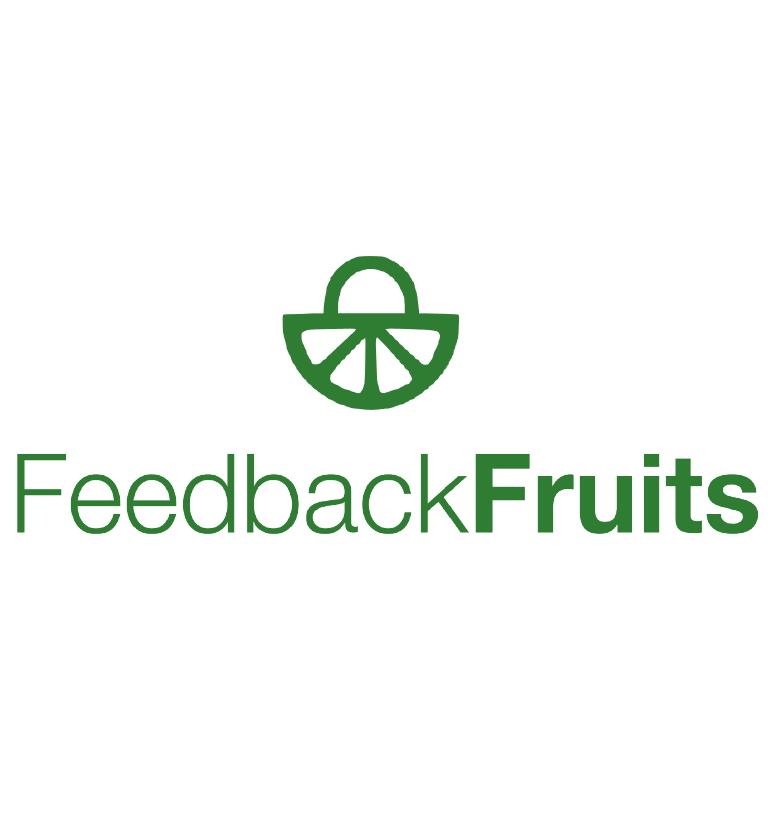FeedbackFruits
FeedbackFruits is a set of tools integrated in Brightspace that enable various ways of interacting with study material and with fellow students. Actively engaging with the course material ensures in-depth processing and promotes learning. Learning is also a social activity, which can be given shape online with FeedbackFruits.
Which tools are included in FeedbackFruits? More importantly, what can you do with them?
Peer Feedback
In FeedbackFruits, the Peer Feedback tool lets students provide feedback on each other’s work. Peer Feedback can be of great value for students’ learning process.
What are the advantages of using Peer Feedback?
- Learning capacity: students learn by reading a fellow student’s work. They find out how someone else thinks about the subject and can compare this to their own work;
- Reflection: as students receive feedback from a fellow student, they learn to reflect on submitted work;
- Improving submitted work: students can improve their work by processing peer feedback.
- Assessing using the criteria of the assessment form: by applying the assessment criteria to the work of others, students understand better what is expected of them.
FeedbackFruits offers various options for giving peer feedback online; these are explained in the Lecturer Course. For example, you can have students give feedback using a rubric, assess groups or give individual feedback. The video below shows the main options:
Interactive video, document and audio
With these tools, a break can be inserted in existing audio, video or articles in order to include questions or discussion items. You can make it mandatory to answer these questions before students can continue watching, listening or reading. In this way, they will not just ‘consume’ the material passively but will have to engage with it actively. Active processing improves long-term memory and makes it easier to retrieve knowledge from long-term memory.
You can ask knowledge questions about the content that students have just encountered or ask challenging questions for students to chew over. The lecturer can view students’ responses, which can provide insight into the knowledge level of the class.
Tip: you can use Interactive document to create an Interactive image. This might be an image in which students have to identify components or a model in which students have to name examples or applications for each component.
Would you like to know how you can start using these tools? The Brightspace Lecturer Course includes instruction materials about Interactive documents, Interactive video and Interactive audio.
Group Member Evaluation
Group members can use the Group Member Evaluation tool to give each other feedback on their achievements and on their cooperation within the group. The lecturer can set predefined criteria for this or leave it to the students to assess in their own way. Reading group member evaluations can provide insight into how cooperation has fared and how much time and effort different group members have dedicated to it. Knowing in advance that their cooperation will also be evaluated can increase students’ commitment and involvement.
Learn more about Group Member Evaluation in the Brightspace Lecturer Course or watch the video:
Video Assignment
This tool is used exclusively for students to submit videos for feedback and/or assessment. The normal submission boxes (in Brightspace Assignments) are not as suitable for submitting videos, as Brightspace does not yet have an adequate playback functionality. So use this FeedbackFruits tool to have students submit videos and to assess these in an easy way!
Setting video assignments can be an excellent opportunity to have students work with the course material in an alternative way. This could include using videos to create and present a product, giving an interview or learning to make and edit videos.
Interactive Presentation
NOTE: for making interactive PowerPoint presentations, we recommend the tool Wooclap. Wooclap is more user friendly and includes more options and functionalities.
In the interactive presentation tool in FeedbackFruits, you can include questions that will be put to students during the lecture, which they can answer immediately. After the lecture, you can reflect on the answers together with your students.
Comprehension of Documents
Reading texts is an individual learning activity that sometimes causes students to get stuck. Comprehension of documents can make reading social and active, so that students understand and retain the information better.
The possibilities:
- You can give prior instructions, such as on how a text relates to previous material and what students should look out for. This makes the reading easier and more effective.
- You can indicate a text’s central themes in the margin. Students can annotate and summarise the relevant passages. This helps them understand the text’s structure, which improves the processing and retention of the information.
- Optionally, students can see each other’s annotations and summaries and respond to these. Collaborative learning is an effective way of activating students.
- It is a mode in which students focus and read without the distraction of social media.
- You as lecturer can track their progress.
Learn more about Comprehension of Documents in the Brightspace Lecturer Course or watch the instruction video:
Discussion Assignment
With the Discussion Assignment tool, you can start up a discussion among students. The tool is comparable to the Discussions tool in Brightspace, the main difference being the layout and a greater focus on peer feedback in the FeedbackFruits Discussion Tool.
In FeedbackFruits, students have to add a contribution and give peer feedback before they can join in an open discussion. This is optional in the Brightspace Discussion tool, where an open discussion about a contribution can be had immediately.
Take the Brightspace Lecturer course to learn more about the Discussion Assignment in FeedbackFruits and the Discussions tool in Brightspace.
Didactic tips
- Having students reflect in writing on the feedback they have received ensures that they engage with the feedback actively and learn from it.
- It is very important to communicate the various deadlines clearly: when can work be submitted, what is the deadline and when are submissions no longer accepted. This is important to be able to connect everyone with other students.
- Use FeedbackFruits in Google Chrome or Firefox for it to run smoothly. FeedbackFruits is not compatible with Safari.

